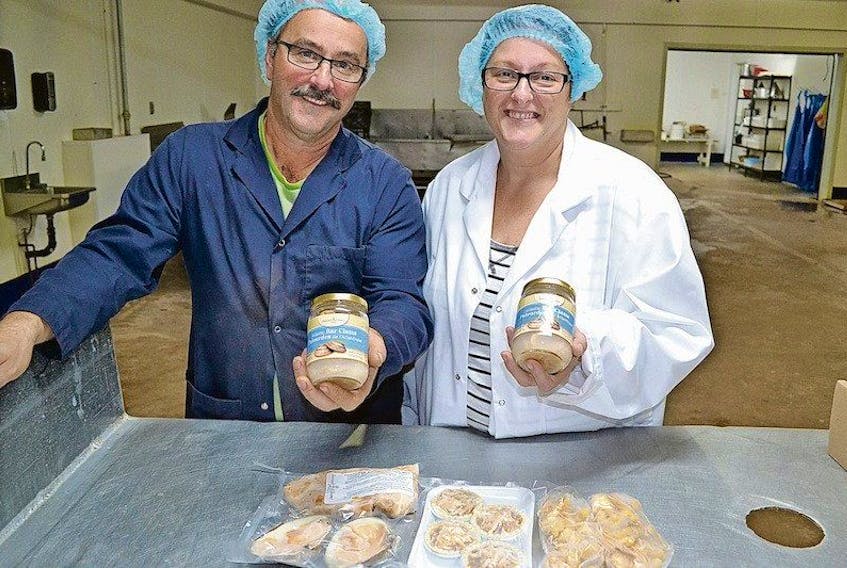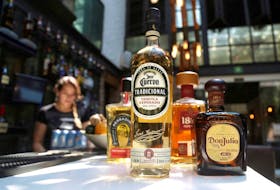CONWAY — The sky’s the limit for Atlantic Canada’s only bar clam processing facility.
Annand Clams owners, David and Carla Annand, started packaging bar clam meat for sale from an 800-square-foot building on their residential property last year.
Since moving into an 8,000-square-foot CFIA-approved facility in Conway this year, the Ellerslie couple has already dramatically increased their product line.
“We either had to go bigger or don’t go at all,” said David. “We wanted to do a lot more innovative products.”
The company’s big seller currently is bottled bar clams, marketed through Sobeys, but there’s high hopes for other products, including breaded clams, clams on the half-shell and a quiche-like bar clam tart.
David fancies the whole clam on the half-shell, cooked on the barbecue.
The breaded clams are becoming a hit with bars, as they are ready from the deep-fryer in two minutes.
“These are just things we’ve served at our own house. Anytime my brothers come home from away, any time we have a seafood dinner, these are the things we serve. It’s like our own menu what we’re cooking now,” said Carla.
“When you think bar clams - 80 per cent of the people - that’s what they think of is a bottle of bar clams,” said David.
Indeed, that’s what they were most familiar with, too. They estimated they were doing home-bottling for close to 30 years.
Bottling for commercial sale, though, is a much more extensive process, requiring CFIA inspection and approval. The owners engaged BioFoodTech in Charlottetown to develop the thermal process for the production of shelf-stable clams in jars.
“With our thermal process, they give us a specific temperature to go to, and how long it’s got to go,” David explained. “This has got to be right on every time.”
With home bottling, he notes, the bathing time might vary.
The company received CFIA approval for its thermal process on Oct. 24 and workers have been bottling ever since.
The clams come from Island fishing boats during the two seasons that run between May 15 and Oct. 15. Annand Clams bought throughout the past season, opened and cleaned the meat, used some for other products and froze most of it until their bottling was approved by CFIA in October. Some of the product was sold in frozen meat packages but most was stored frozen until bottling could commence.
The owners anticipate they have enough product in storage to keep three workers employed until the end of January.
They are already looking at new products, including a frozen bar clam chowder in a microwaveable bag, and they are just getting started on a fishcake product. That’s the only product that doesn’t involve the use of bar clams.
They anticipate having to hire more staff next year.
Clam facts
Facts about bar clams (Spisula Solidisima):
- Thick, chalky shell, covered with a thin olive-brown skin
- Popular for bottling and canning and for use in chowders, stews and clam-strip meals
- The largest clams available in the northwest Atlantic region
- Can be found from Labrador to the Gulf of Mexico
- Most abundant in the southern and western Gulf of St. Lawrence.
- In Prince Edward Island, harvest seasons range from April to December.
Source: Prince Edward Island Seafood Guide, P.E.I. Dept. of Fisheries, Aquaculture and Rural Development.
CONWAY — The sky’s the limit for Atlantic Canada’s only bar clam processing facility.
Annand Clams owners, David and Carla Annand, started packaging bar clam meat for sale from an 800-square-foot building on their residential property last year.
Since moving into an 8,000-square-foot CFIA-approved facility in Conway this year, the Ellerslie couple has already dramatically increased their product line.
“We either had to go bigger or don’t go at all,” said David. “We wanted to do a lot more innovative products.”
The company’s big seller currently is bottled bar clams, marketed through Sobeys, but there’s high hopes for other products, including breaded clams, clams on the half-shell and a quiche-like bar clam tart.
David fancies the whole clam on the half-shell, cooked on the barbecue.
The breaded clams are becoming a hit with bars, as they are ready from the deep-fryer in two minutes.
“These are just things we’ve served at our own house. Anytime my brothers come home from away, any time we have a seafood dinner, these are the things we serve. It’s like our own menu what we’re cooking now,” said Carla.
“When you think bar clams - 80 per cent of the people - that’s what they think of is a bottle of bar clams,” said David.
Indeed, that’s what they were most familiar with, too. They estimated they were doing home-bottling for close to 30 years.
Bottling for commercial sale, though, is a much more extensive process, requiring CFIA inspection and approval. The owners engaged BioFoodTech in Charlottetown to develop the thermal process for the production of shelf-stable clams in jars.
“With our thermal process, they give us a specific temperature to go to, and how long it’s got to go,” David explained. “This has got to be right on every time.”
With home bottling, he notes, the bathing time might vary.
The company received CFIA approval for its thermal process on Oct. 24 and workers have been bottling ever since.
The clams come from Island fishing boats during the two seasons that run between May 15 and Oct. 15. Annand Clams bought throughout the past season, opened and cleaned the meat, used some for other products and froze most of it until their bottling was approved by CFIA in October. Some of the product was sold in frozen meat packages but most was stored frozen until bottling could commence.
The owners anticipate they have enough product in storage to keep three workers employed until the end of January.
They are already looking at new products, including a frozen bar clam chowder in a microwaveable bag, and they are just getting started on a fishcake product. That’s the only product that doesn’t involve the use of bar clams.
They anticipate having to hire more staff next year.
Clam facts
Facts about bar clams (Spisula Solidisima):
- Thick, chalky shell, covered with a thin olive-brown skin
- Popular for bottling and canning and for use in chowders, stews and clam-strip meals
- The largest clams available in the northwest Atlantic region
- Can be found from Labrador to the Gulf of Mexico
- Most abundant in the southern and western Gulf of St. Lawrence.
- In Prince Edward Island, harvest seasons range from April to December.
Source: Prince Edward Island Seafood Guide, P.E.I. Dept. of Fisheries, Aquaculture and Rural Development.









